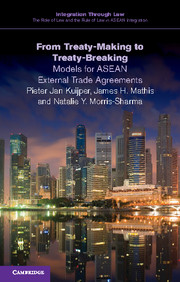Book contents
- Frontmatter
- Contents
- General editors' preface
- List of abbreviations
- 1 Introduction
- 2 Substantive components of an ASEAN trade agreement from an external perspective
- 3 Moving forward: different institutional models for ASEAN's external trade agreements
- 4 The rules on dispute settlement in agreements between ASEAN member states and third states: a critical inventory
- 5 From treaty-making to treaty-breaking
- Executive summary
- Appendix 1 Agreements signed by ASEAN member states with a non-ASEAN party
- Appendix 2 ‘Non-ASEAN’ agreements
- References
- Index
2 - Substantive components of an ASEAN trade agreement from an external perspective
Published online by Cambridge University Press: 05 April 2015
- Frontmatter
- Contents
- General editors' preface
- List of abbreviations
- 1 Introduction
- 2 Substantive components of an ASEAN trade agreement from an external perspective
- 3 Moving forward: different institutional models for ASEAN's external trade agreements
- 4 The rules on dispute settlement in agreements between ASEAN member states and third states: a critical inventory
- 5 From treaty-making to treaty-breaking
- Executive summary
- Appendix 1 Agreements signed by ASEAN member states with a non-ASEAN party
- Appendix 2 ‘Non-ASEAN’ agreements
- References
- Index
Summary
Introduction
This chapter considers the third-country view ‘looking in’ on ASEAN and its member states as potential preferential trading partners. It identifies some of the subject areas treated in current preferential trade agreements (PTAs) and asks, what can we expect potential demandeurs for trade arrangements with ASEAN member states to be requesting in any prospective agreement?
The approach here is to take up some identified subject areas in order to draw comparisons between them across a number of selected trade agreements. The subjects examined have a mix of characteristics across a range of legality, as some tend to be more legally enforceable (binding), while others express a soft law approach. Another axis examined concerns the character of the subjects: some are traditional ‘border’ types of issues (e.g., customs, anti-dumping and safeguarding measures), while others are more ‘behind the border’ and concern domestic regulatory policies. Treatment of product standards or competition policy would be examples of the latter. In comparing the subjects treated by different trade agreements, some patterns emerge that reflect the predominant models facing ASEAN and its member states in their future trade negotiations. Having identified these patterns, we consider their implications for ASEAN's own institutional framework as it attempts to either satisfy the demands of the subjects or to deal with them in the capacity of ASEAN's preferred approaches. This could raise points of deficiency in the existing ASEAN institutional approach to external agreements. However, it may also identify some elements unique to the ASEAN style from its own integration experience that it can highlight and bring to future negotiations.
Much of this chapter focuses on subject areas in the realm of domestic regulation, ‘behind the border’ rules that function as non-tariff barriers in PTAs. In such agreements, these subject areas are often treated by cooperative approaches – in contrast to more legally binding approaches – in order to facilitate either the removal of identified barriers or the gradual alignment of the differing regulatory systems of the trade agreement signatories.
- Type
- Chapter
- Information
- From Treaty-Making to Treaty-BreakingModels for ASEAN External Trade Agreements, pp. 20 - 86Publisher: Cambridge University PressPrint publication year: 2015



